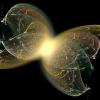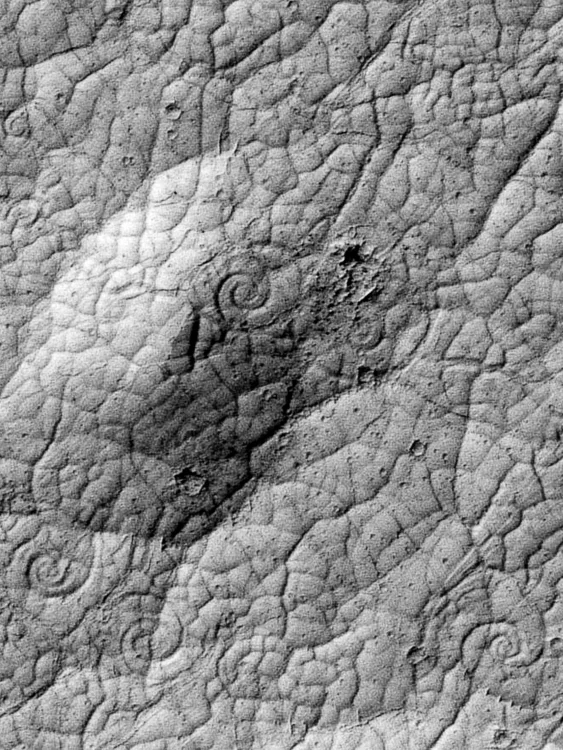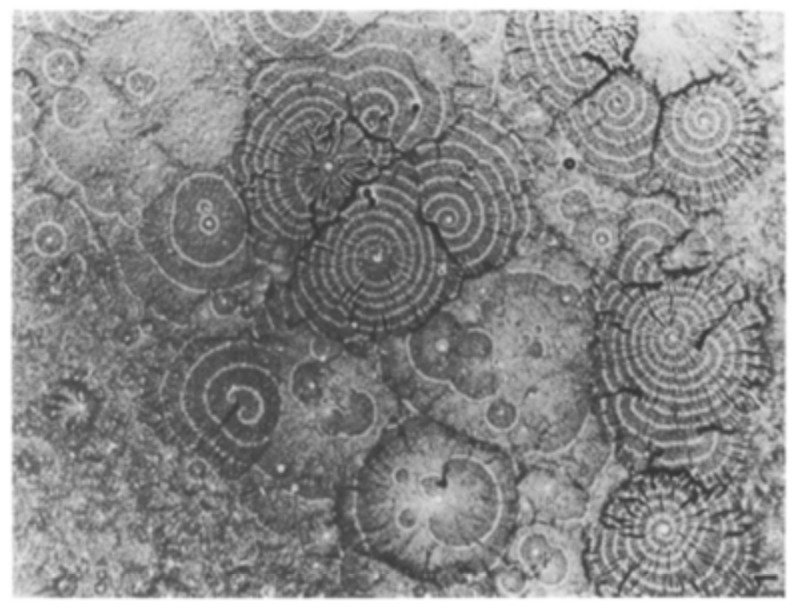-
Posts
174 -
Joined
-
Last visited
Content Type
Profiles
Forums
Events
Everything posted by AbnormallyHonest
-
Please watch this video before joining in the discussion. Assuming you watched the video or you already know something about eukaryotic protists like slime molds, than the following photos should at the very least be a topic of discussion. This is a photograph taken from the Mars Reconnaissance Orbiter on December 17, 2017. Credit: NASA/JPL-Caltech/University of Arizona Now after seeing the video on top, do you believe there could be some argument that this could be an example of a cellular protist aggregation on a very large scale on the surface of Mars? If you look closely at the photograph you will be able to see evidence of the aggregation selecting its route across the Marian surface. The path shown obviously being the one selected by the aggregation. Here are some other examples, this one from December 3, 2006. This on June 25, 2021 Credit: NASA/JPL-Caltech/University of Arizona After studying many photos of Mars, I have come to the conclusion that these formations are a type of extraterrestrial protist in aggregation on the surface of Mars. The reason we do not recognize it immediately is because it is so different than life as we know it here on Earth. Well why shouldn’t it be, it is alien after all. Another thing that these “slugs” will do is form spore like fruiting bodies in order to reproduce. Perhaps on mars it might look something like this photo taken in January of 2010. Credit: NASA/JPL-Caltech/University of Arizona I could literally show example after example of that would support this claim, which I will do and I’ll leave the discussion to you. Scientists are unable to explain why these “dunes” are so isolated from one another. This is not a natural formation. Credit: NASA/JPL-Caltech/University of Arizona If you look closely at the last photograph, if you look closely at the run of the formation it is difficult to try to explain the natural processes that caused the rock to look like this. Here are some side-by-side comparisons of things that exist here on Earth and things that have been seen on Mars. Slime mold taken here on Earth. Photo of an unknown object on the surface of Mars. Here is a photo of familiar shapes etched into the surface of Mars with no explanation. This is a photograph of a formation from a slime mold on a much smaller scale.
- 1 reply
-
-1
-
The reason for this “torque” that was mentioned is due to the discrepancy between the center of gravity and the center of mass. For most of our everyday purposes we can consider these two thing synonymous, because we live and exist in a uniform gravitational field. Celestial bodies experience gravity on a much more dynamic scale, and therefore this can shift the center of gravity away from the center of mass. This discrepancy is what causes tidal forces.
-
Guass’ Law assumes a sphere, but Newton’s did not. All mass, no matter how irregular, has a center of gravity. That is one point.
-
Yes this is true. Tidal forces could cause a translation in the center of gravity. Besides the fact that these forces are acting laterally in relation to Phobos, and dismissing the fact that tidal effect takes place on both the facing and opposing side of mass, or the fact that the forces acting on earth are much more powerful and are acting on a surface that is 80% liquid, which is far more viscous than the nearly dead core of the entire planet Mars, you still have the the point that the center of mass is still the center of mass. That’s one point each... please explain how two (only two) points exert “torque” on one another?
-
I’m not speaking on the synchronicity of Phobos’ rotation to Phobos’ revolution... not Mars. So you’r saying angular momentum is transferred to Mars? So on Mars the Sols are becoming shorter? I’ve never heard that before. So that would mean Phobos’ rotation is slowing down while it’s orbital period is accelerating, how does it maintain a tidal lock?
-
So they say Phobos, the inner moon of Mars, is on a collision course with Mars. Ok, I don’t disagree with that. I also do not doubt that this deteriorating orbit has something to do with the orbital period being lass than the rotation of the planet. My question is, Phobos is tidally locked to Mars, and it’s rotation vs revolution are synchronous, where does the angular momentum come from? With a deteriorating orbit, as the moon falls toward the surface, the orbital period will become shorter. As that happens, wouldn’t the frequency of rotation need to increase in order to remain synchronous with the orbital period? Where does the energy for that increase come from? Is it possible that the energy to maintain that synchronicity is the cause of the deterioration? Could Phobos, at some point lose its tidal lock and begin a rotation that is less than its revolution? If that were to happen could this halt the deterioration? If you believe that the moon creates a bulge that... blah, blah, blah.... then you doubt Issac Newton’s Gravitational Constant or Carl Guass who also had a law that states, “The gravitation flux between any surface is proportional to the enclosed mass.” To calculate a bulge that transfers energy from any vector other than the center of mass goes against both these well accepted universal laws of physics.
-
According to modern physics, we know that particles and light behave very differently under observation than they do unobserved. An unobserved field of energy is just that, and evenly distributed field of potential that requires a recorded measurement to “fix” it to a single position or a set path. Most pysiscists also agree that the disparity of energy vs. observation is disproportionately in favor of more energy than we are able to explain at this time. We call it dark energy. I believe, along with many others, that the Universe continues beyond our ability to observe. One possible explanation is the light hasn’t had enough time to reach our vicinity in space. In any case, so what about all the stuff that we can’t “measure and/or record?” If it’s unobservable out there than doesn’t that mean that it’s potentially in a lot of places. Doesn’t that also mean it’s potentially in places That are observable? If that were true wouldnt that create the disparity in the amount of energy that is a part of our observable univers as opposed to what we believe “should” be a part of our observable universe? If it exists there, then it potentially exists here as well, but it could potentially exist within and outside our universe if it is measured and recorded there too. That could cause it to exist here as a phantom energy like dark energy or zero point energy, but what would be the trade off?
-

Interference vs. Lensing
AbnormallyHonest replied to AbnormallyHonest's topic in Astronomy and Cosmology
I do understand, the difference being refraction separates the colors because of the change in velocity through another medium, this causes the oscillations from different wavelengths to change directions which is both a factor of the angle in which it enters the medium and proportional to wavelength. (e.g. some light gets refracted more than others, or it is a discrete influence proportional to wavelength...) This separates the colors producing all those pretty colors. Diffraction produces all those pretty colors in a much different way, it does this through interference. Diffraction is what happens in G-lensing because there is no change in medium, (although you might argue that the gravitational field or the curvature of spacetime could be considered a change of medium, but as it does not have a discrete influence proportional to wavelength is doesn't produce all those pretty colors) but if the surface is not flat, (which space hardly ever is, especially in gravitational fields) it causes the light to interfere with itself, producing, as you state so eloquently, all those pretty colors... but only at the fringes. Also, I don't believe that a double slit caused this affect, but a double slit is a reproducible experiment here on Earth, with measurable results that can also make predictions. Could you please reproduce gravitational lensing in a laboratory? Hmmm... well if that's not possible, how about using G-lensing to explain all these validating observations that don't require something we can't see, can't explain, and don't even know if it is real? I am not the one chasing the Easter Bunny. -

Interference vs. Lensing
AbnormallyHonest replied to AbnormallyHonest's topic in Astronomy and Cosmology
Yes, diffraction of white light, now what if you removed the boundaries of the slits? There would only be the center blockage, but the diffraction would only occur toward the center because at the extremes, there would be a direct view of the light. Now place your perspective between the rainbow fringes and what do you see? Also, wouldn't gravitational lensing be considered refraction because the light passes through a gravitational field with variable strength? Only it does not have discrete manipulation of wavelength so it is a diffraction. Having the same object appear in more than one place seems like we do observe exactly that. -
I do revel in it, as do you, being a frequent responder to my fraudulent inferences and unsupported claims (which I do appreciate). Revel in it because it interests me. I read the Holy Vedas, a Buddhist Sutra, the Holy Qur'an, the Holy Bible, the Torah, and the Kitab-I-Aqdas (Bahi' Faith), as I keep hard copies in my living room at all times. During my three Bible study groups and attendance at two services every week also seems to weirdly revel as well. Unfortunately, I don't find that they are able to provide a comprehensive understanding of the reality that I seem to perceive. So then I revel in Carl Sagan, Richard Feynman, Isaac Newton, Stephen Hawking, or even Charles Darwin (Epic in scale and perception, but dreadfully dry). This leads me to study things like Quantum Mechanics, String Theory, Relativity, Field theory, Infinite Set Theory. Which forces you begin to understand things like integrated calculus, probability distributions, Law of Squares, Monster Modules, J-invariance, Q-functions, or Infinite Sets. Still I continue to explore authors like Jung, Maslow, all the way back to Immanuel Kant... I even have a collection of Edgar Cayce as well, and the only thing that I've come to learn absolutely, is that everything becomes interesting at a deep enough level. So in all those things I revel in, there isn't really anyone in my whole reality that I know that seems to be able to have a conversation with me without me having to introduce a lot of old ideas in order to present one new one. So I look for outlets, this forum being one of them. I use it to present some ideas in areas that don't make sense to a lot of people. Whether or not you believe me, I do understand the accepted theories, at least on a conceptual level, as well as some of the math, but not well enough to be fluent (disambiguation from Newton's method, no pun intended). Part of the reason I do, is because of the feedback I receive from people like yourself, so thank you sincerely. I'm not trying to change anyone's mind or make a bold statement, I'm just trying to figure it out just like everyone else.
-

Dark Energy as a Consequence of Chronometric Scaling.
AbnormallyHonest replied to AbnormallyHonest's topic in Speculations
Chronometry is the science of the measurement of time. What is the difference between a second for you and second for me? Nothing, yet that doesn't seem to always be true. If we're standing next to one another, yes it is true, but the greater our displacement in space, the greater the chronometric displacement. It's a scaling effect, so the measurement only changes if measured from a spatial displacement. This is a direct relationship. The expansion of space is actually just chronometric displacement, because science tells us that space and time are connected, so spatial displacement must be synonymous with a displacement in time. We experience time the same, because gravity causes us all to experience the same spatial displacement from one another, for the most part. Even in orbit, the range of our displacement is farther, but not that far. I believe relativistic effects are just our experience of displacement, not velocity. If we were very far apart, the only way we would be able to maintain stasis in relation to one another would be to travel in a direction toward one another, and if we were traveling toward one another from very displaced locations, say on scales of the most distant objects we see, we would have to move toward one another at close to the speed of light. A those velocities, we wouldn't actually remain static, we would absolutely decrease the displacement between us, even if we tried to balance it perfectly because the measurement of your time from me would be scaled, as would your perception of my time from your clock. We would essentially be narrowing the displacement much faster than we thought possible, (but our rate of displacement would decelerate as we approached one another as our clocks began to normalize). Dark energy is exactly the same thing in reverse. Everything is moving away from us because of its spacial displacement, which is technically increasing all the time while our clocks measure time from within our gravity well. If I look in one direction and see the farthest objects moving away from us, and simultaneously have a telescope pointed in the opposite direction and see the same thing, then technically aren't those two points moving apart, with respect to one another, in a way that is theoretically impossible? How could that be possible? Because spacetime are one. Spacial displacement is also chronometric displacement. (Think of Einstein's problem with the clocks. It wasn't resolved until the transfer of information was fast enough to measure time on Earth from one clock.) Sorry for all the words, but you're one of the smartest members I've seen, so I thought it would be worth the effort. -

Interference vs. Lensing
AbnormallyHonest replied to AbnormallyHonest's topic in Astronomy and Cosmology
If you get colored fringes, isn''t that different than what you would see in diffraction? I'm pretty sure a diffraction crystal projects a rainbow pretty uniformaly, it isn't just the fringes... so we can rule it out. The double slit experiment produces an interference pattern... it has interference, it interferes with itself, and yes interference behaves differently depending on differing wavelengths. At the fringes, the probability changes, as does the probability of both constructive and destructive interference dependent on the wavelength of light. Amplifying some and destroying others with discretion because it is, as you say, on the fringes of a non-discrete distribution of probability. Yes there is a matter of scale, but wouldn't anything presented on scales of that magnitude really just speculation... I mean, unless we've been there to observe, or at least from a displacement of equal magnitude. -

Interference vs. Lensing
AbnormallyHonest replied to AbnormallyHonest's topic in Astronomy and Cosmology
Excuse me if you please... yet you have empirical evidence of dark matter, or is just a dark area of understanding due to the disparity between the concepts we believe and observation. Rather than inventing something just to validate a concept that doesn't work, why not apply real science, such as Young's Double Slit, which is a reality, and should be applied to other situations. I'm not invalidating it, observation does, unless, of course, applying some real science to the dark areas of understanding might shed some light on the dark areas of science. P.S. Yes I enjoyed the video very much, but what do you care what other people think? -

Interference vs. Lensing
AbnormallyHonest replied to AbnormallyHonest's topic in Astronomy and Cosmology
Yes, but only to in mentioning it as not being a factor in the explanation. Really, I do believe in gravitational lensing, but I do not believe that it is the whole story. I'm not presenting a new idea, I'm only applying an old one in a new way. Really I should be defending Young's Double slit, wave theory, and string theory, because that is what's being dismissed by SF members. So what your saying is that they are both true... like 2+2=4 but 2x2=4 as well? I wonder who mentioned that earlier...? I hope you understand what I mean. -

Interference vs. Lensing
AbnormallyHonest replied to AbnormallyHonest's topic in Astronomy and Cosmology
Well, I would agree with you, but the diffraction patters are due to the different wavelengths of light, which all enter a changing medium differently causing disparity in the angles of diffraction for varying colors. This isn't the case with gravitational lensing, because there is no change in medium and therefore none in velocity. If you check out TUB's post there's a link to Fermat's Principle which helps explain this. -

Interference vs. Lensing
AbnormallyHonest replied to AbnormallyHonest's topic in Astronomy and Cosmology
Thank you, for the links. Yeah, and I wonder if there are any scientists that have ever done that before? Who said anything about gravity? Actually I'm offering a solution so no one needs to come up with an alternate explanation for gravity, because what if there is no "dark" matter? What happens to relativity then? -

Interference vs. Lensing
AbnormallyHonest replied to AbnormallyHonest's topic in Astronomy and Cosmology
Yes, this is true, for light traveling through varying densities, because it changes the the speed the light travels through it. Since energy is a field, it doesn't all enter the change in medium at the same time (from our perception) so we perceive it as a shift in the light. (e.g. a pencil in a glass of water) The speed of light in a vacuum is constant. There is no changing medium, which would mean no alteration in velocity, therefore this principle doesn't really have any relevance to gravitational lensing. I'm not making crap up anymore than anyone else who uses speculation to dismiss speculation. Yes, I am aware that there are widely accepted concepts to logically rationalize observation, and some of those have extrapolated to make predictions, but does that mean that it is actually a reality, or just a very intuitive concept? Believing a concept is the reality is a disability of progress. The table I'm using to type on feels solid to me, but isn't matter mostly just space and fields of energy? So which is the reality and which is a speculative concept? I'm no more making crap up than anyone else. Science has many definitions, but to me, it is the promotion of discovery through progressive insightful concepts that seek the truth of reality, not rigidly clinging to concepts that didn't have all the information and can't explain everything. If new ideas weren't scientific, then we'd still be in the stone age. I'm not looking to convince people that I'm absolutely correct, I'm looking for help, which is what I thought this forum was for. Diffraction formula doesn't apply, because the diffraction occurs in the field, not the angle or direction of the light. What does change is the amount of time it takes for the light to arrive, but since we see it arriving all at once, we see portions of the same image stretched across more time. Gravity could be bending space, which shifts the direction of the light, or the field could just be gaining a new focal point, causing our view of the angular diameter to be arriving with different travel times, which distorts our view of things. We perceive an object as a whole with the light arriving together, but really we're just seeing a field that is composed of light from differing times. -
If we see the Universe’s rate of expansion as accelerating, it’s probably due to relativistic dilation due to apparent velocity. If we were able to approach lightspeed, time would “slow” down. So for every second that passes from that perspective, more time would pass for everyone else.So say we were moving at ~86% the speed of light, the relativistic dilation of time at that velocity would be ~50% of what others would experience. One second from both perspectives would be one second, but our seconds would be two seconds for everyone else. From our view, things would appear to be in fast forward … like people would move faster, the days would be half as long, as would the year, as would the progressive evolution of the entire Universe, (as well as the apparent age). Lightspeed would also be twice as fast as well, because from our perspective, it would move twice as far in one second than it did before. (This is why it is not achievable.) The further objects are, the faster their apparent velocity to us, so they would appear to be in slow motion. On a scale of the age of the Universe, those objects, and the space that they exist, would actually be younger than us. This can easily be verified by any observation of distant objects in space. The farther out we look, the younger the Universe appears. So what of our view of the Earth being in fast forward? Well, from a relativistic perspective, would we be moving at ~86% the speed of light, or would Earth and the entire Solar System be moving at ~86% the speed of light in relation to us? We would then see the Earth progressing slower, there is no fast forward unless we could orbit the Earth at those velocities (so Earth would be relatively static from our perspective). So what is “Dark Energy”? Well, the farther out we look, the younger things look, but also anything that has a relative rate of displacement that approaches “c” would appear to have chronometric scaling, causing them to age “slower”. Relativity dictates that relative motion causes a dilation in the flow of time, but the dilation relationship to velocity is not proportionately linear. Nor is the progressive age of the Universe as we look farther into space, and further in time. So, from our perception of time as compared to distant objects perception of time progresses at an accelerated rate. So, from their perception of light, how much space would be covered by one of their seconds? How much in one of ours? How would that be translated by the light that we see?* *(Assuming that the light itself must experience the same relativistic dilation, which is why we only see the moment the light leaves. They are simultaneous, so one second at the origin is the same second here.)
- 4 replies
-
-1
-

Interference vs. Lensing
AbnormallyHonest replied to AbnormallyHonest's topic in Astronomy and Cosmology
well actually, interference would be the shortest distance between two points without a direct line of sight. It doesn't require curvature. Also, seeing an object where it doesn't have direct line of sight doesn't mean that it has resonance, the "pattern" we see is merely due to probability that a single photon will likely end up here due to the overlap of the distribution between the two focal points. The photons are actually fired one at a time and don't resonate with anything other than probability. Yes, but if I predicted that 2(_)2=4 aren't there two solutions that work. If I added 2(_)3=6 you might get a better picture. Or would I say that it was supposed to be 8 but dark order of operations must be preventing it from growing past 6? -
Perhaps.... you're not one of those "Flat Earth" advocates are you?
-
The caret (^) symbolizes that the following number is superscript. Yes, you do. Thank you. Which has more, if I count to infinity in evens, or in 5's? What has more value, 2/infinity or 5/infinity? It doesn't matter which numbers you use, if you're rationalizing it's value to infinity, the separation of the values is always the same, you're just changing the labels.
-

Interference vs. Lensing
AbnormallyHonest replied to AbnormallyHonest's topic in Astronomy and Cosmology
Have you ever heard of a conoscopic interference pattern? (https://en.wikipedia.org/wiki/Conoscopic_interference_pattern) It's a type of spectrographic analysis of minerals, something I've just discovered myself, but I believe it is relevant. Unfortunately, I don't have a lab, but if you were to take a double slit interference pattern and rotate the slits around the center point of where the light makes contact with the slits, you'd end up with a very similar pattern. -

Interference vs. Lensing
AbnormallyHonest replied to AbnormallyHonest's topic in Astronomy and Cosmology
There is one that has no math or experimental results supporting it... and it's not circular interference. I would say that relativity is the "other explanation" which requires the idea of "dark matter" just to make it fit. On the other hand, interference patterns can be experimentally validated right here on Earth, and can be replicated anywhere... it does not require the chance occurrence of some very unique celestial coincidences and the inclusion of some speculative stuff that we do not yet even have a concept of. I'm not implying that it explains every visual coincidence we observe, but it might offer another explanation that can be recreated here in a lab without including anything speculative. -
Did gravity exist before there was a concept to describe it? Sure, things fell to the ground predictably... but how predictably? Would a two spheres of differing masses fall at the same rate? Probably not before Galileo actually did the experiment himself. If the behavior existed exactly as it does now, why are there no records or eyewitness accounts of this occurring before Galileo. Even if you could travel back in time and speak to anyone who lived before that time, there would be very few people that would verify that the behavior was exactly the same as we conceptualize it today.
-
Yeah, you can delete this topic. It was an idea I started, and accidentally posted... twice I believe.






